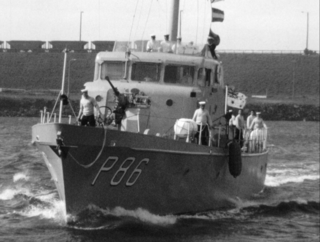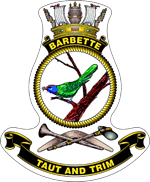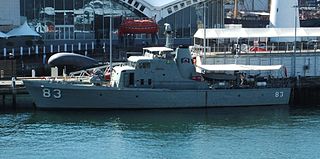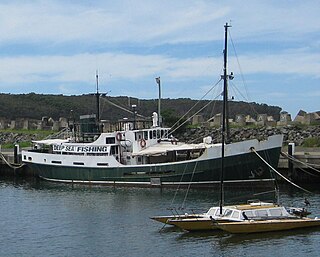Related Research Articles

HMAS Barcoo (K375/F375/A245) was a River-class frigate of the Royal Australian Navy (RAN). One of twelve frigates constructed in Australia during World War II, Barcoo, was laid down by Cockatoo Docks & Engineering Company, Sydney in 1942, and commissioned in early 1944.

HMAS Archer was an Attack-class patrol boat of the Royal Australian Navy (RAN).

HMAS Ardent was an Attack-class patrol boat of the Royal Australian Navy (RAN). She was built by Evans Deakin and Company, and was commissioned into the RAN in 1968. Ardent was decommissioned in 1994, then assigned as a navigation training vessel. At the end of 1998, she was removed from service. Initially marked for preservation at the Darwin Military Museum, the vessel was sold into civilian service in 2001 after the Northern Territory government declined. In 2002, the patrol boat was acquired by the Indonesian Navy, and commissioned as KRI Tenggiri (865) in 2003.

HMAS Arrow was an Attack-class patrol boat of the Royal Australian Navy (RAN).
HMAS Bandolier was an Attack-class patrol boat of the Royal Australian Navy (RAN).

HMAS Barbette was an Attack-class patrol boat of the Royal Australian Navy (RAN).
HMAS Flinders, named for Matthew Flinders (1774–1814), was a hydrographic survey ship of the Royal Australian Navy (RAN). Built by HMA Naval Dockyard at Williamstown, Victoria, Flinders was commissioned into the RAN in 1973, and was used to conduct hydrographic surveys in the waters to Australia's north, including parts of New Guinea. In 1974, the ship was tasked with assisting clean up efforts in the wake of Cyclone Tracy, which devastated large parts of Darwin. The ship was decommissioned in 1998 and sold to civilian operators, who have since converted her into a private yacht in the Cayman Islands.

HMAS Lae was an Attack-class patrol boat of the Royal Australian Navy (RAN). It was named for the city of Lae, capital of Morobe Province, Papua New Guinea. Completed in 1968, the vessel was one of five assigned to the RAN's Papua New Guinea (PNG) Division. The patrol boat was transferred to the Papua New Guinea Defence Force in 1974 as HMPNGS Lae. She remained in service until 1988.

HMAS Labuan (L3501) was a Mark III Tank Landing Ship that served in the Royal Navy during World War II, and with the Royal Australian Navy (RAN) from 1946 until 1951.

HMAS Wewak was the fifth ship of the Balikpapan class of heavy landing craft operated by the Royal Australian Navy (RAN).

HMAS Banks was an Explorer class general-purpose vessel of the Royal Australian Navy (RAN), serving in a range of capacities from 1960 until 1995. She was named in honour of Sir Joseph Banks, the botanist aboard HM Bark Endeavour during the discovery of the eastern coast of Australia in 1770.

HMAS Lae (L3035) was a Landing Ship, Tank which was operated by the Royal Navy and Royal Australian Navy (RAN). She was built by William Denny and Brothers at Dumbarton, Scotland during World War II and was launched on 24 October 1944.

No. 73 Wing was a Royal Australian Air Force (RAAF) wing of World War II. It was formed in February 1943 at Port Moresby, Papua New Guinea, as part of No. 9 Operational Group. The wing initially comprised three attack squadrons flying CAC Wirraways, Douglas Bostons, and Bristol Beaufighters, with which it took part in the New Guinea campaign until mid-year. It was then reorganised with three fighter squadrons operating P-40 Kittyhawks and Supermarine Spitfires; in this form it saw action in the New Britain and Admiralty Islands campaigns through 1943–44. The wing was disbanded at Los Negros in August 1944, and by the beginning of 1945 its squadrons had been absorbed into other RAAF wings under No. 10 Operational Group.

The Explorer class was a two-ship class of general purpose vessels of the Royal Australian Navy that served between 1960 and 1995.

TB 191 was a second-class torpedo boat constructed for the Colony of Tasmania and later operated by the Commonwealth Naval Forces and the Royal Australian Navy. She was sold in 1911.
Esturia was a 2,143 gross register ton oiler, built by Armstrong Whitworth & Company, Walker in 1910. She operated as an oil tanker for the Burmah Oil Company, before being chartered by the Royal Australian Navy on 11 September 1914, during the First World War, as an oiler and stores ship. She served as the destroyer depot ship for HMAS Swan, Huon, and Torrens in Australian and Malayan waters. After being dispatched to Port Said, Egypt with the destroyers, she was transferred to the Admiralty.
Murex was a 3,564 gross ton M class oiler, built by William Gray & Company, West Hartlepool in 1892 for Marcus Samuel & Company. She was the first bulk-oil tanker to pass through the Suez Canal en route to Thailand in 1892. She was chartered by the Royal Australian Navy and took part in operations against the German colonies in the Pacific with the Australian Naval and Military Expeditionary Force during the First World War in 1914, as an oiler. Murex was given the battle honour "Rabual 1914", for her service. She was later requisitioned by the Admiralty.

Whangape was a cargo ship measured at 2,931 gross register tons (GRT), built in 1899 by Sir Raylton Dixon & Co., Middlesbrough. The vessel was constructed for the British Maritime Trust as Adriana, sold while on the slips to Elder, Dempster & Company and renamed Asaba. Her engine was built by T Richardson & Sons, Hartlepool.
HMAS Coogee was a passenger ferry that briefly served as a Royal Australian Navy armed patrol vessel and minesweeper in the latter part of the First World War. She was launched in 1887 and scuttled in 1928.

HMAS Bass was an Explorer class general-purpose vessel of the Royal Australian Navy (RAN), serving in a range of capacities from 1960 until 1994.
References
- Gillett, Ross (1986). Australia's navy : past, present & future. Brookvale, NSW: Child & Henry. ISBN 0-86777-178-X.
- Odgers, George (1982). The Royal Australian Navy : an illustrated history. Brookvale, NSW: Child & Henry. ISBN 0-86777-240-9.